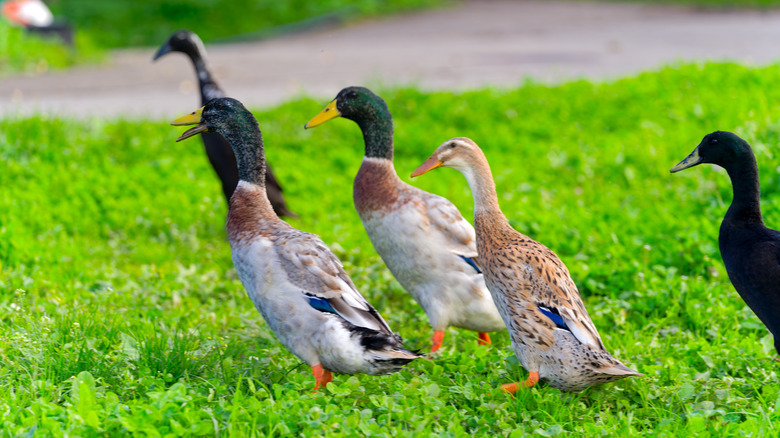How To Tell The Difference Between A Male & Female Indian Runner Duck
Shaped like bowling pins with webbed feet and a beak, Indian runners are some of the most efficient egg layers of all duck breeds, making them one of the best options for the farm pond. Although they can all look very much alike, it's fairly easy to tell which duck is male and which is female from their physical build, feathering, and even coloration.
Listen to their voices
You don't need to try to catch or pick up an Indian runner duck to know which is male or female — they'll happily tell you. Females, known as hens, make the typical "quack quack" sound, and do so loudly and proudly, as they use this vocalization to summon their ducklings, attract mates, and otherwise communicate over long distances.
Female ducklings start quacking at 4 or 5 weeks old, but you might notice a difference in sound before then. Like male ducklings, females make a peeping sound, but it is sometimes interspersed with a strange coughing sound that denotes a developing quack. Male ducklings have a monotone peep that is completely unpunctuated by any other sound. Indian runner drakes stay rather monotone as they become mature. Their low, whispery grunts make them far quieter to keep than their noisier female counterparts.
Check their beaks and feet
The female Indian runner duck has a bright yellow or orange beak, sometimes with spots of black pigment as she grows older. By contrast, a male has a paler bill that is pinkish in color.
Male Indian runners are larger than the females, so they will have larger feet with thicker legs to support their bigger bodies. When Indian runner ducklings hatch, the males usually tend to outgrow the females right from the start. They'll develop bigger feet and more widely spaced legs within the first few days and weeks.
Note the feathers
You might notice that some adult Indian runner ducks have a curly feather on their tail and others do not. The curly feather is known as a drake feather, and it develops when a male is sufficiently mature enough to mate. A hen's tail has feathers that are uniform across the back. The top feathers lay down flat and do not curl. When spread, the tail feathers are uniform in size and form an even, rounded edge.
Sex-linked Indian runner drakes
Indian runners can be bred to produce female ducklings that are chocolate in color. The sex-linked coloration is based on using a chocolate-colored drake, who has two copies of the chocolate gene. When bred to a non-chocolate female, he will pass on the chocolate coloration to his daughters only.
Sex-linked Indian runners are available online, making it easy to name your new ducklings and observe the physical attributes and sounds of each sex while knowing who's who. Keep in mind that future generations of mixed colors won't follow the sex-link pattern since their genetics are different, and you will have males and females of mixed colors.
